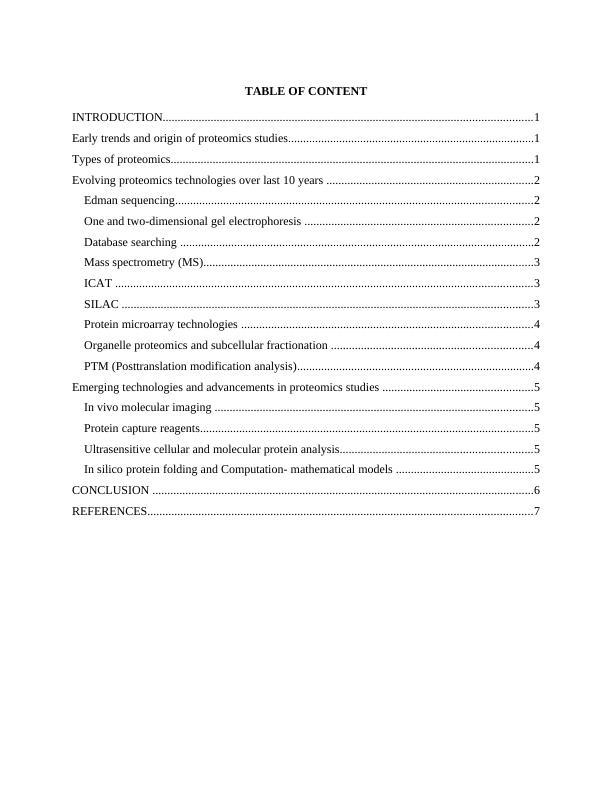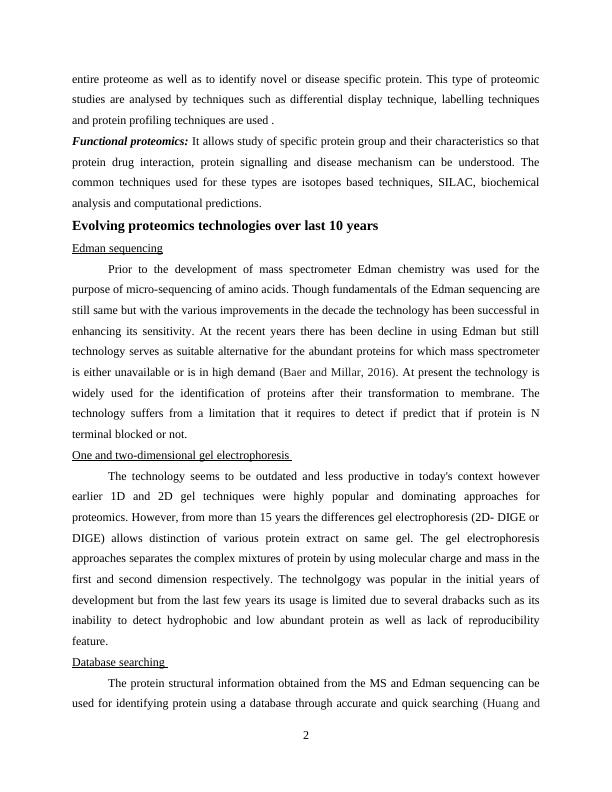Ask a question from expert
Proteomics Technologies - PDF
13 Pages2663 Words310 Views
Added on 2021-02-20
Proteomics Technologies - PDF
Added on 2021-02-20
BookmarkShareRelated Documents
Compare and contrast theway in which proteomicsstudies are performed incurrent literature as opposedto those performed ten yearsago

TABLE OF CONTENTINTRODUCTION...........................................................................................................................1Early trends and origin of proteomics studies..................................................................................1Types of proteomics.........................................................................................................................1Evolving proteomics technologies over last 10 years .....................................................................2Edman sequencing.......................................................................................................................2One and two-dimensional gel electrophoresis ............................................................................2Database searching ......................................................................................................................2Mass spectrometry (MS)..............................................................................................................3ICAT ...........................................................................................................................................3SILAC .........................................................................................................................................3Protein microarray technologies .................................................................................................4Organelle proteomics and subcellular fractionation ...................................................................4PTM (Posttranslation modification analysis)...............................................................................4Emerging technologies and advancements in proteomics studies ..................................................5In vivo molecular imaging ..........................................................................................................5Protein capture reagents...............................................................................................................5Ultrasensitive cellular and molecular protein analysis................................................................5In silico protein folding and Computation- mathematical models ..............................................5CONCLUSION ...............................................................................................................................6REFERENCES................................................................................................................................7

INTRODUCTIONProteomics studies are defined as the study of protein functions and structure inbiological samples. These studies play significant role in exploring understanding related tonature and function of the organisms. Contrary to the proteomics studies of 10 years ago thepresent studies use more advanced, bioinformatic and simulated technology based proteomicstools for high throughput analysis (Bakalarski and Kirkpatrick, 2016). The current proteomicstechniques also allows post translational modifications and quantitative comparison of variousproteomics. A decade ago the appropriate technologies were not sufficient for providing suchcomparative analysis. The comparative evaluation of these technologies is helpful to select appropriateapproach for proteome profiling and to understand the interaction between various proteins. Thereport will provide a comparative analysis of ways in which proteomics studies are performed atpresent as well as a decade ago. Study will assist to understand the bioinformatic tools whichdeveloped for accessing and storing proteomic data and to statistically ascertain the proteinidentification from single peptide match. Early trends and origin of proteomics studiesBefore 10 years ago use of two-dimensional protein electrophoresis (2-DE) wereconsidered as the major developments signifying proteomics studies. However, the technique haslimitation that it lacks sequencing technology for sensitive protein. The drawback was resolvedby the Edman degradation and micro sequencing techniques. This technique is used for creationof 2-D database. In the last 10 years the sensitivity of mass spectrometry approach has improvedin terms of sensitivity so that protein mixture can be tolerated and technology has successfullyreplaced Edman sequencing (Mallick and Kuster, 2010). The growth and development ofproteomics is the result of nucleotide sequencing of genomic DNA and sequencing tags. Types of proteomicsProteomics is classified into three major categories which are as follows: Structural proteomics: These studies aims at mapping protein structure and proteins of cellularorganelle. This cell map based proteomics type uses techniques such as PTM analysis todetermine the function and site of the proteins. Protein expression: It is type of quantitative study in which protein expression of varioussamples with distinguish feature are studied. Protein expression studies also allow to compare1

entire proteome as well as to identify novel or disease specific protein. This type of proteomicstudies are analysed by techniques such as differential display technique, labelling techniquesand protein profiling techniques are used . Functional proteomics: It allows study of specific protein group and their characteristics so thatprotein drug interaction, protein signalling and disease mechanism can be understood. Thecommon techniques used for these types are isotopes based techniques, SILAC, biochemicalanalysis and computational predictions.Evolving proteomics technologies over last 10 years Edman sequencingPrior to the development of mass spectrometer Edman chemistry was used for thepurpose of micro-sequencing of amino acids. Though fundamentals of the Edman sequencing arestill same but with the various improvements in the decade the technology has been successful inenhancing its sensitivity. At the recent years there has been decline in using Edman but stilltechnology serves as suitable alternative for the abundant proteins for which mass spectrometeris either unavailable or is in high demand (Baer and Millar, 2016). At present the technology iswidely used for the identification of proteins after their transformation to membrane. Thetechnology suffers from a limitation that it requires to detect if predict that if protein is Nterminal blocked or not. One and two-dimensional gel electrophoresis The technology seems to be outdated and less productive in today's context howeverearlier 1D and 2D gel techniques were highly popular and dominating approaches forproteomics. However, from more than 15 years the differences gel electrophoresis (2D- DIGE orDIGE) allows distinction of various protein extract on same gel. The gel electrophoresisapproaches separates the complex mixtures of protein by using molecular charge and mass in thefirst and second dimension respectively. The technolgogy was popular in the initial years ofdevelopment but from the last few years its usage is limited due to several drabacks such as itsinability to detect hydrophobic and low abundant protein as well as lack of reproducibilityfeature.Database searching The protein structural information obtained from the MS and Edman sequencing can beused for identifying protein using a database through accurate and quick searching (Huang and2

End of preview
Want to access all the pages? Upload your documents or become a member.
Related Documents
Functional Proteomicslg...
|10
|2921
|59
Grape Skin Proteomics Reportlg...
|15
|3705
|161